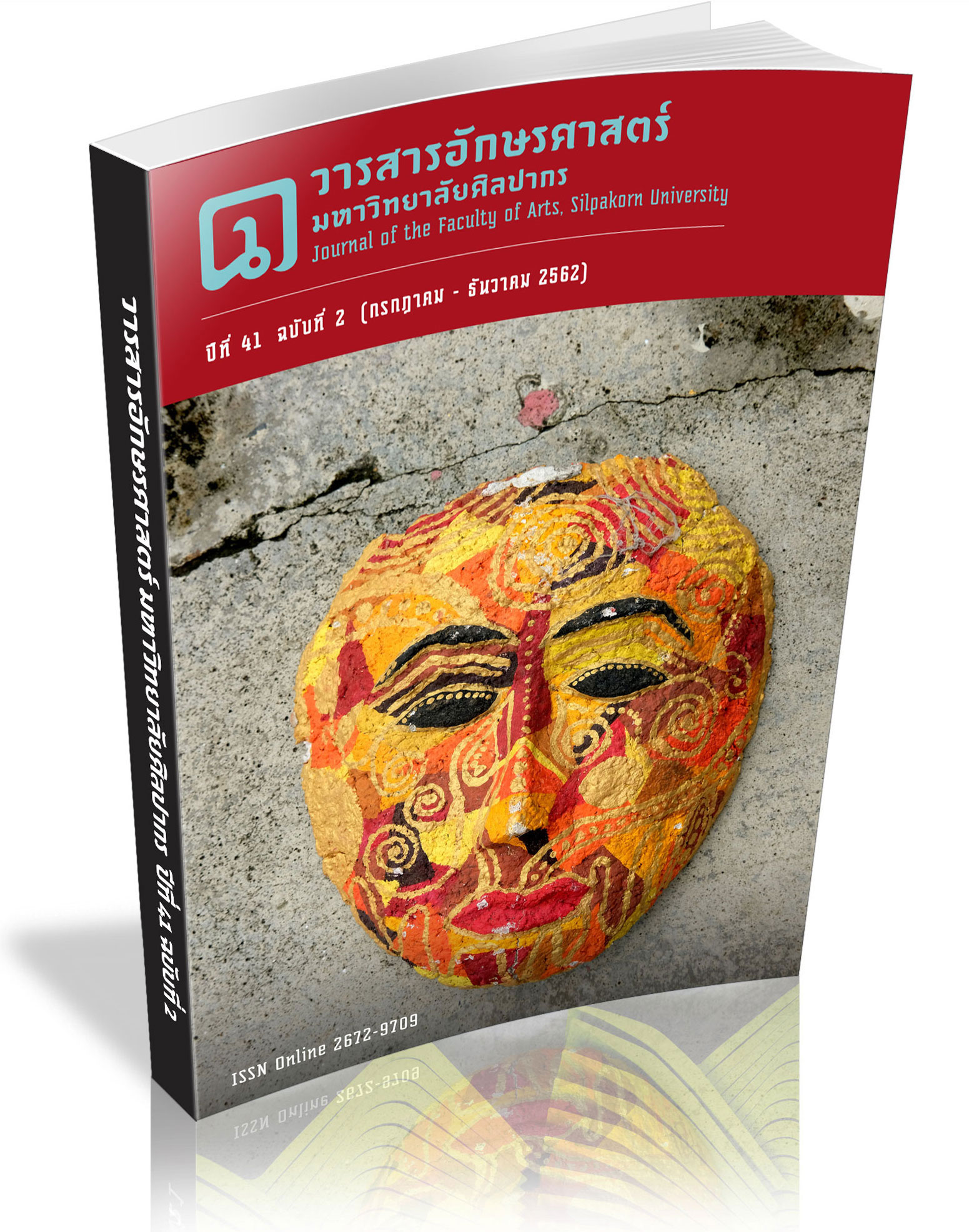From the Huni Kuin Rite to the Ernest Neto’s Creativity of Arts
Keywords:
Ernesto Neto, Huni Kuin, Ayahuasca, Experience of space, Installation artAbstract
Ayahusca is a medicinal rite of Amazonian natives. The rite was inherited by Huni Kuin, indigenous people, whose lifestyle depends on nature. The tribal lifestyle corresponds to Ernesto Neto’s belief. For half of a decade, Ernest Neto, a Brazilian contemporary artist, has learnt and created arts on the basis of Huni Kuin’s belief and culture. This article aims to examing his artistic creativity, which leads appreciators to perceive the arts along with the story of the tribe. According to the concept of space and perception, Ernesto Neto has connected the Huni Kuin world with the external world in his art space to create experience of a place for the appreciator.
Downloads
References
Art Gallery of New South Wales. (n.d.). Just like drops in time, nothing. Retrieved from https://www.artgallery.nsw.gov.au/collection/works/276.2002/
Cigainero, J. (2015). Healing art: a spiritual journey with Ernesto Neto and the Huni Kuin tribe at Vienna’s TBA21. Retrieved from https://www.wallpaper.com/art/healing-art-a-spiritual-journey-with-ernesto-neto-and-the-huni-kuin-tribe-at-viennas-tba21
Coutinho, T. (2016). Forest shamanism in the city: The kaxinawá example. Sociologia & Antropologia, 6(1): 159-179.
Fernando, C. (2018). What is rapé. Retrieved from https://katukina.com/doc/rape
Garcia, C. (2015). Fantastic voyages of Ernesto Neto: Rio superstar takes Viennahis fall. Retrieved from https://www.newcitybrazil.com/2015/10/01/fantastic-voyages-of-ernesto-neto-rio-superstar-takes-vienna-this-fall
Goldstein, I. S., & Labate, B. C. (2018). From the forest to the museum: Notes on the artistic and spiritual collaboration between ernesto neto and the huni kuin. In Labate, B. C., & Cavnar, C. (Eds.), The expanding world ayahuasca diaspora: Appropriation, integration and legislation (pp. 76-94). London: Routledge.
Guntli, R. (n.d.). Ernesto Neto at Augarten TBA21-Vienna. Retrieved from https://www.retoguntli.com/art1
Lagrou, E. (2018). Anaconda-becoming: Huni kuin image-songs, an Amerindian relational aesthetics. Horizontes Antropológicos, 24(51): 17-49.
Langhammer, F. (2018). Ernesto Neto. Retrieved from https://www.collectorsagenda.com/en/in-the-studio/ernesto-neto.
Lynch, K. (1960). The Image of the City. Cambridge, MA: MIT Press.
Machon, J. (2011). (Syn)aesthetics: Redefining visceral performance. New York: Palgrave Mac millan.
Mateus de Lima, F. A. (2017). Life in the Amazon. Retrieved from http://mappingmedicine.org/life-in-the-amazon.
Merleau-Ponty, M. (1964). The Film and The New Psychology. In Sense and non-sense, 48-59. Evanston, III: Northwestern University Press.
__________. (2002). Phenomenology of perception. Abingdon, UK: Taylor & Frrancis.
Mpurusha. (2017). Ayahuasca and the boa mother. Retrieved from https://queenoftheforest.org/ayahuasca/auto-draft.
Norberg-Schulz, C. (1980). Genius loci: Towards a phenomenology of architecture. New York: Rizzoli.
Olea, S. (2017). Shamans and scientists: The healing power of ayahuasca supported by neuroscience. Retrieved from https://www.elciudadano.com/ciencia-tecnologia/chamanes-y-cientificos-el-poder-sanador-de-la-ayahuasca-apoyado-por-la-neurociencia1/04/24/#
Pallasmaa, J. (2014). Space, place, and atmosphere: Emotion and peripheral perception. Leb answelt: Architectural experience. 4: 230-245.
Pinacoteca de São Paulo. (2019). Pinacoteca Ernesto Neto. Retrieved from http://greatpice.pw/pinacoteca-ernesto-neto.html
Sales, I. V. (n.d.). The Huni Kuin people. Retrieved from http://hibridos.cc/en/rituals/povo-huni-kuin
Seidler, L. (2015) TBA21: Ernesto Neto and the Huni Kuin - Aru Kuxipa / sacred secret. Retrieved from https://www.flickr.com/photos/eselat/with/18970824008
Silva, J. T., & Farbiarz, J. L. (2017). Creating from natural materials: Huni kuin material culture. Strategic Design Research Journal, 10(1): 47-56.
Soley, M. (2016). Mapu Huni Kui e Isaka Huni Kui. Retrieved from https://www.youtube.com/watch?v=KBhKMy3tNWs
Stenros, A. (1993). Orientation, Identification, Representation Space and Perception in Architecture. Endoscopy as a Tool in Architecture: Proceedings of the 1st European
Architectural Endoscopy Association Conference, 75-88. Tampere, Finland: Tampere University of Technology.
Tanya Bonakdar Gallery. (2012). Ernesto Neto: Slow iis goood. Retrieved from http://www.tanyabonakdargallery.com/exhibitions/ernesto-neto/17
__________. (n.d.). Ernesto Neto: Large scale installation. Retrieved from http://www.tanyabonakdargallery.com/artists/ernesto-neto/series-large-scale-installation/7
Zumthor, P. (2006). Atmospheres: architectural environments: Surrounding objects. 5th ed. Basel, Switzerland: Birkhäuser.
Zyman, D., Ebersberger, E., & Wildförster, F. S. (2015). Aru Kuxipa. Berlin: Sternberg Press.
Downloads
Published
How to Cite
Issue
Section
License
ผู้เขียนบทความต้องยินยอมในข้อกำหนดต่าง ๆ ของวารสารก่อนส่งบทความตีพิมพ์




